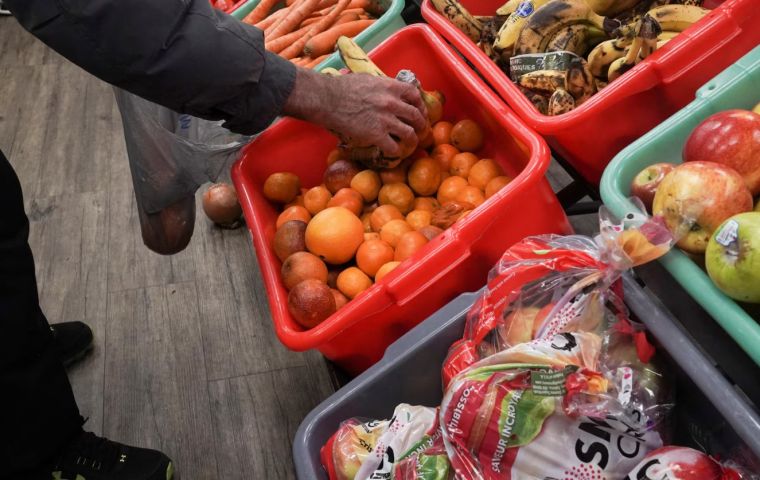MercoPress. South Atlantic News Agency
November FAO Food Price Index, highest since April 2023, boosted by dairy and vegetable oils
 Additionally, the weakening of the Brazilian Real against the United States dollar and lower international crude oil prices contributed to the decline in world sugar prices
Additionally, the weakening of the Brazilian Real against the United States dollar and lower international crude oil prices contributed to the decline in world sugar prices The FAO Food Price Index, FFPI, averaged 127.5 points in November 2024, up 0.5 percent from the October level and reaching its highest value since April 2023. The increase was driven by higher price quotations for dairy products and vegetable oils, which slightly outweighed declines in the meat, cereals, and sugar quotations. Compared to historical levels, the FFPI in November was 5.7 percent higher than its corresponding value a year ago but remained 20.4 percent below its peak of 160.2 points reached in March 2022.
The Cereal Price Index averaged 111.4 points in November, down 3.0 points (2.7 percent) from October and 9.6 points (8.0 percent) below its November 2023 value. Global wheat prices declined month-on-month due to increased supplies from the ongoing harvests in the Southern Hemisphere and improved crop conditions for the 2025 harvests in some major Northern Hemisphere exporting countries. Weaker international demand also contributed to the softer price tone. World maize prices remained stable in November as a result of opposing factors. Downward pressure on prices stemmed from generally favorable weather in South America with the continuing sowing, weaker demand for Ukrainian supplies, and seasonal pressure from the ongoing harvest in the United States of America, while strong domestic demand in Brazil and Mexico’s demand for US supplies provided upward support. Among other coarse grains, world prices of barley and sorghum declined slightly in November. The FAO All Rice Price Index declined by 4.0 percent, driven by price falls across major market segments resulting from increased market competition, harvest pressure, and currency depreciations against the United States dollar.
The Vegetable Oil Price Index averaged 164.1 points in November, rising 11.4 points (7.5 percent) month-on-month to reach its highest level since July 2022. The increase was driven by higher quotations for palm, rapeseed, soy and sunflower oils. International palm oil prices increased for the sixth consecutive month, maintaining a premium over alternative oils due to lingering concerns about lower-than-expected global production amid excessive rainfall in Southeast Asia. Meanwhile, world soy oil prices also continued to rise, mainly due to robust global import demand. Similarly, prices of rapeseed and sunflower oils increased, reflecting prospects of tightening global supplies in their respective markets.
The Dairy Price Index stood at 139.9 points in November, up 0.9 points (0.6 percent) from October and 23.4 points (20.1 percent) above its level a year ago. International quotations for milk powders, in particular whole milk powder, registered the largest increases, driven by a rebound in global demand and the seasonal decline in milk production in Western Europe, which offset rising seasonal milk production in Oceania. World butter prices increased for the fourteenth consecutive month, reaching a new record high due to strong internal and international demand amid tight inventories, particularly in Western Europe. Cheese prices also rose, reflecting limited availabilities to meet growing import demand for spot supplies.
The Meat Price Index averaged 118.1 points in November, down 0.9 points (0.8 percent) from the revised October value but up 6.6 points (5.9 percent) from a year ago. The decline was mainly due to lower international pig meat prices, which fell for the fifth consecutive month, principally driven by weaker quotations in the European Union, reflecting abundant supplies and persistently subdued global and domestic demand. Ovine meat prices declined slightly in November, influenced by currency movements despite strong international demand. Similarly, world poultry meat prices fell marginally, pressured by ample export supplies from major producing regions. Meanwhile, international bovine meat quotations remained broadly stable. A sharp rise in Brazilian bovine meat prices, fueled by robust global demand, was offset by lower Australian prices due to reduced purchasing interest from the United States of America.
Finally the Sugar Price Index averaged 126.4 points in November, down 3.1 points (2.4 percent) from October, following two consecutive monthly increases, and as much as 35.0 points (21.7 percent) below its level a year ago. The decline in November is attributed to the start of the crushing season in India and Thailand, along with eased concerns over next year’s crop prospects in Brazil. While increased rainfall in key southern growing regions of Brazil disrupted harvest progress during the month, it improved soil moisture, benefiting the upcoming crop after a prolonged period of dry weather. Additionally, the weakening of the Brazilian Real against the United States dollar and lower international crude oil prices contributed to the decline in world sugar prices.




Top Comments
Disclaimer & comment rulesCommenting for this story is now closed.
If you have a Facebook account, become a fan and comment on our Facebook Page!